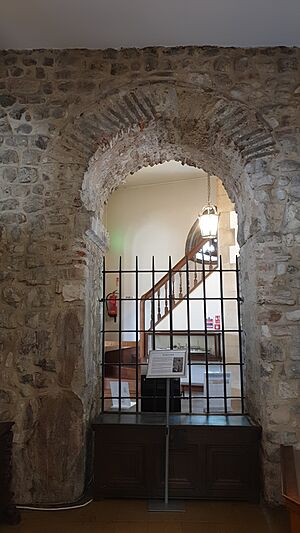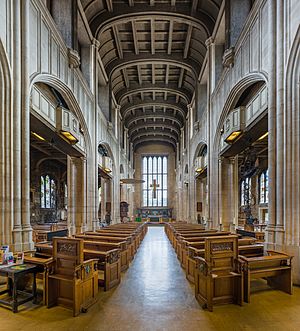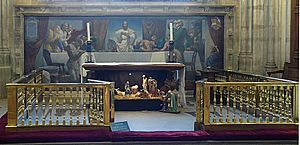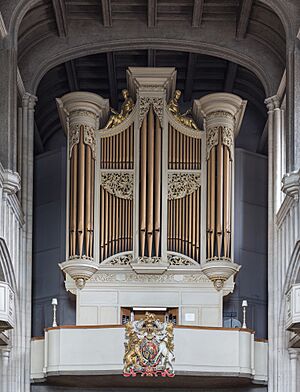All Hallows-by-the-Tower facts for kids
Quick facts for kids All Hallows-by-the-Tower |
|
|---|---|
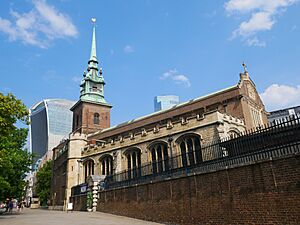
All Hallows-by-the-Tower in 2020
|
|
| 51°30′34″N 0°04′46″W / 51.5094°N 0.0794°W | |
| OS grid reference | TQ 33385 80687 |
| Location | Byward Street London, EC3 |
| Country | England |
| Denomination | Church of England |
| Previous denomination | Roman Catholic |
| Churchmanship | Modern Catholic |
| Architecture | |
| Heritage designation | Grade I listed building |
| Administration | |
| Diocese | Diocese of London |
All Hallows-by-the-Tower is a very old Anglican church in the City of London, England. It stands near the famous Tower of London. Sometimes, people call it All Hallows Barking.
This church is thought to be the oldest church in the City of London. It was possibly founded way back in AD 675. The church managed to survive the Great Fire of London in 1666. However, it was badly damaged during the Blitz in World War II. After a lot of rebuilding, it reopened in 1957.
From 1922 to 1962, a special vicar named Tubby Clayton led the church. He founded Toc H, which is an international Christian group. All Hallows-by-the-Tower is still the main church for Toc H today.
Contents
History of All Hallows-by-the-Tower
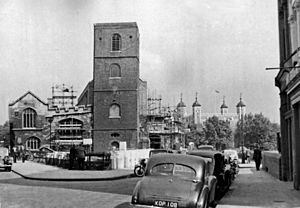
The early history of All Hallows-by-the-Tower is a bit of a mystery. In 1539, the church belonged to Barking Abbey. This was a Roman Catholic nunnery (a place where nuns lived) in Barking. The church had been linked to Barking Abbey for a very long time. In the 12th century, it was even called "Berkyncherche."
The original Anglo-Saxon Barking Abbey was started by Earconwald. He later became the Bishop of London in 675. Some people believe the land for All Hallows was given to the abbey around that time. This was when Æthelburh, Erkenwald's sister, was the abbess.
Discoveries from the Past
In 1940, during World War II, bombs damaged the church. When the rubble was cleared, workers found an old archway. It was built with reused Roman tiles and stones. This archway was very old, possibly from the 7th century. This discovery seemed to support the idea that the church was founded around the same time as Barking Abbey.
It's likely that the first church here was made of wood. The stone church, with its ancient arch, probably replaced it later. More recent studies suggest the arch could have been built anytime between the 7th and 11th centuries. Pieces of three stone crosses from the 11th century were also found. These are now on display in the church's crypt.
Changes Over Time
The church was made bigger and rebuilt many times. This happened between the 11th and 15th centuries. You can still see parts of the Norman, 13th-century, and 15th-century buildings today.
Because it was so close to the Tower of London, the church had royal connections. King Edward IV made one of its chapels a royal chantry (a place for prayers). People who were executed at the Tower of London were often buried here temporarily. One famous person buried here was Sir Thomas More.
Surviving Disasters
In 1650, the church was badly damaged by an explosion. Barrels of gunpowder stored nearby blew up. This destroyed the church's west tower and about 50 houses. Many people died. The tower was rebuilt in 1658.
The church almost didn't survive the Great Fire of London in 1666. But Admiral William Penn saved it. He was the father of William Penn who founded Pennsylvania. Admiral Penn had his men blow up nearby buildings. This created gaps that stopped the fire from spreading to All Hallows. Samuel Pepys, a famous diarist, climbed the church's tower to watch the fire. He called it "the saddest sight of desolation."
The church was restored in the late 1800s. Then, German bombers severely damaged it during the Blitz in World War II. It needed a lot of rebuilding and was rededicated in 1957. Many parts of the old church survived the war and were carefully repaired. Its outer walls are from the 15th century. The Anglo-Saxon archway is still there from the very first church.
Inside, you can see many old brass plaques. There are also three amazing wooden statues of saints from the 15th and 16th centuries. The church also has a beautiful Baptismal font cover. It was carved in 1682 by Grinling Gibbons and is considered one of London's best carvings. The large painting behind the main altar was done by Brian Thomas after the war.
In 1999, archaeologists dug up the church cemetery. They found many important things.
The Crypt Museum
The church has a museum in its crypt (an underground room). It holds parts of a Roman pavement found deep below the church in 1926-1927. The museum shows the history of the church and London. It has Anglo-Saxon items and religious objects. You can also see the church's old registers from the 16th century.
Famous entries in the registers include the baptism of William Penn. Also, the marriage of John Quincy Adams is recorded there. William Laud, an Archbishop, was buried in the crypt for over 20 years. His body was later moved to St John's College, Oxford. The crypt also has chapels dedicated to St Francis and St Clare. It also has a columbarium, which was created in 1933.
The altar in the crypt is a plain stone. It came from the castle of King Richard I in The Holy Land.
All Hallows-by-the-Tower was named a Grade I listed building on January 4, 1950. This means it's a very important historic building.
Famous People Connected to the Church
Many interesting people have connections to All Hallows-by-the-Tower:
- John Quincy Adams: He later became the sixth president of the United States. He was married here in 1797.
- Philip Clayton: Known as 'Tubby', he was a vicar here and founded Toc H.
- William Penn: He was baptized here in 1644. He later founded the state of Pennsylvania in America.
- Albert Schweitzer: A famous musician and doctor, he made organ recordings at All Hallows.
- Thomas More: A famous writer and statesman, he was buried here temporarily after being executed at the Tower in 1535.
The Church Organ
The first records of an organ at All Hallows are from 1521. This organ was probably lost during the English Civil War.
A new organ was put in by Thomas and Renatus Harris in 1675. Over the years, the organ was repaired and improved by different builders. It was destroyed in 1940 during World War II. A new organ was installed in 1957 by Harrison and Harrison.
Organists of All Hallows
- Albertus Bryne II (1675–1713)
- Charles Young (1713–1758)
- Charles John Frederick Lampe (1758–1767)
- Samuel Bowyer (1767–1770)
- Charles Knyvett and William Smethergell (1770–1783)
- William Smethergell (1783–1823)
- Mary Morrice (1823–1840)
- Lisetta Rist (1840–1880)
- Arthur Poyser
- Gordon Phillips (1956–1991)
- Jonathan Melling
Traditions and Ceremonies
The church has a special bell system called a chime. It was fixed and brought back to working order in the 1970s.
Every June, the church holds the Knollys Rose Ceremony. It starts at the church and goes to the Mansion House. There, a single rose is given to the Lord Mayor as a special payment. The church also has an annual "beating the bounds" ceremony. This includes a boat trip onto the River Thames to mark the church's southern boundary.
Images for kids
-
The font, with carvings by Grinling Gibbons
-
William Penn memorial
See Also
- List of buildings that survived the Great Fire of London
- List of Churches in London
- Malta George Cross Memorial (a memorial located just outside the church)


